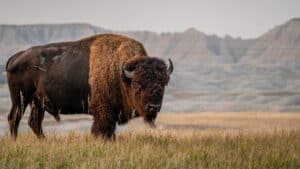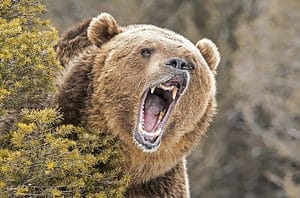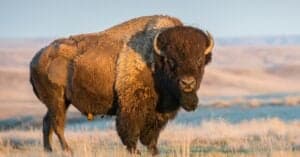Bison (Bison bison) are the largest mammal in North America. Bison means “wild ox,” and these animals resemble oxen with their thick, shaggy fur and large head and neck. While some people refer to them as buffalos, that is incorrect. Bison and buffalo are entirely different animals and have many key differences. While it may be easy to notice the difference between a bison and a buffalo, it can be harder to notice the differences between male and female bison. What are the differences? How can you distinguish between the two? What are their roles and characteristics? This article will answer all of those questions and more as we dive into the key differences between male and female bison.
Comparing a Male and Female Bison
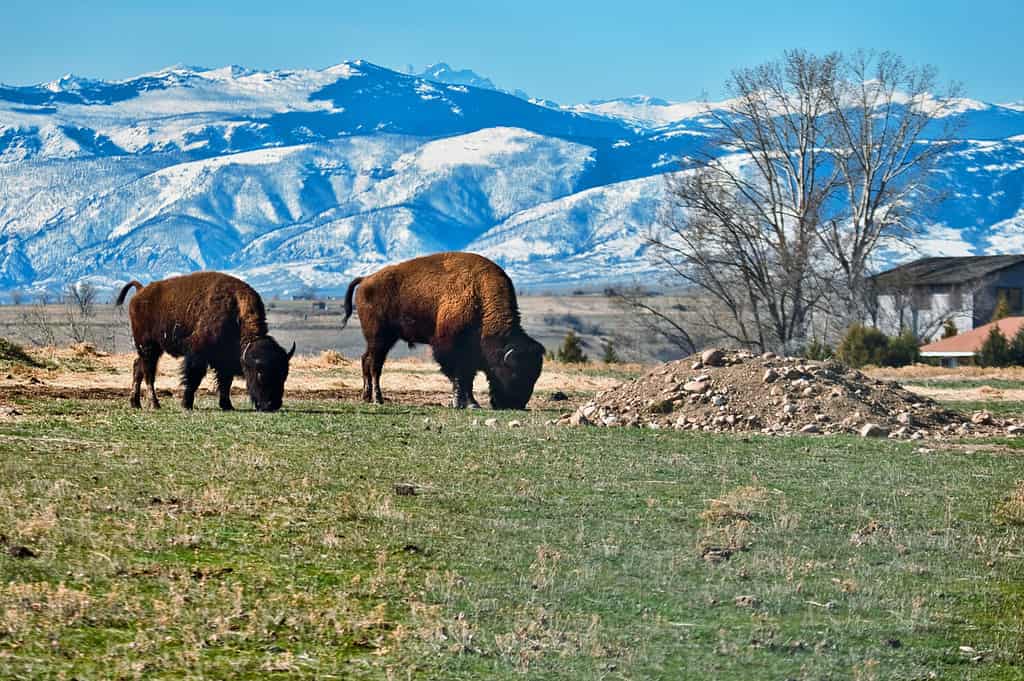
A key difference between male and female bison is their horns. Male bison have heavy, less curved horns, while females have thinner horns that curve more inward.
©Steve Creek/Shutterstock.com
Male bison are referred to as bulls, and female bison are referred to as cows. Despite having different names, what else differentiates these two genders of bison? How can you tell the difference between a male and female bison? Here are a few telltale characteristics that set them apart from one another.
| Difference | Male | Female |
|---|---|---|
| Size | Males weigh up to 2,000 pounds and stand 6 feet tall | Females weigh up to 1,000 pounds and stand between 4 and 5 feet tall |
| Physical Traits | Larger head Less curved horns Wide shoulders | Narrow heads Inward-curved horns Wide hips |
| Reproduction | Reach sexual maturity at six years Mate with many females | Reach sexual maturity between two and three years Mate with one male |
| Roles | Show dominance and find a mate. | Reproduce and raise offspring. |
| Temperament | More aggressive than females. | Less aggressive than males but still unpredictable. |
5 Key Differences Between a Male and Female Bison
While the entirety of the species share similar characteristics, such as having horns, feet with two toes, and a four-chambered stomach, there are some key differences between them. The key differences between male and female bison are their size, head and horn shape, roles in reproduction and the herd, and temperament. This article will take a deep dive into each of those differences and provide more details. Let’s dive in!
Male vs. Female Bison: Size
While both the male and female bison are massive in their size, the male is larger than the female. The average male bison weighs around 2,000 pounds and reaches about 6 feet in height. They also reach between 10-12 feet in length. The female is around 1,000 pounds and only reaches between 4 and 5 feet in height. Females typically reach about 7 feet in length. When looking at the two species, the female is noticeably the smaller of the species.
Male vs. Female Bison: Physical Traits
Besides their weight and height, other physical traits help differentiate the male from the female bison. One of those traits is their head. The male bison’s head is large and block-like. Additionally, it is generally covered in thick and curly fur. The male’s horns are heavy at the base and have less of an inward curve than the cow’s horns do. In addition to their heads, the male bison also have thicker fur on their forelegs, and their beards are more dense.
The cow’s head is narrower than the bull’s, and her horns are thinner and more curved inward. Also, she has a tuft of hair that can be found on the underside of her belly. Besides her head, a cow’s shoulders are narrower than her hips. This differs from the bull, whose shoulders are broader than its hips.
Male vs. Female Bison: Reproduction
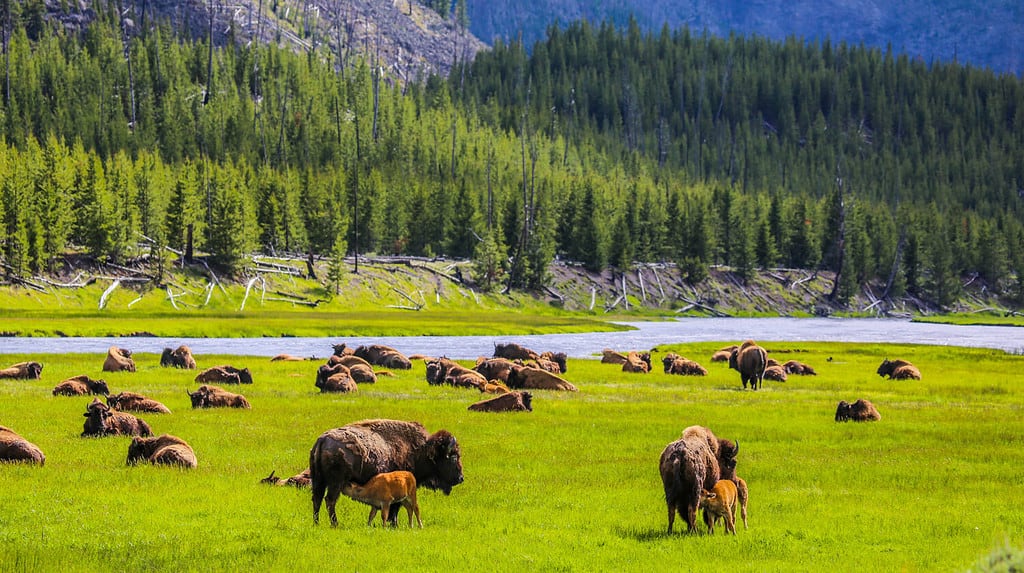
Another key difference between male and female bison is when they reach sexual maturity. Female bison reach sexual maturity between two and three years of age, while male bison do not reach it until six years.
©Gjeterhund Photography/Shutterstock.com
Wallowing serves a purpose for reproduction. Sexually mature males will urinate in the wallow — during mating season — to showcase their physical condition to other male bison. Male bison will also headbutt and charge one another to assert dominance and showcase strength to attract a mate. They also bellow to attract their mates. Male bison reach sexual maturity around six years.
Female bison carry the calves, and they gestate for about 285 days. Similar to humans, female bison have live births and usually only produce one offspring at a time. Another difference between male and female bison regarding reproduction is that males will mate with multiple females, while females will only mate with one male. Females reach sexual maturity between two and three years of age.
Male vs. Female Bison: Role
Male and female bison have very different roles in the herd. In fact, did you know that they spend the majority of the year in separate herds? That’s right, for the majority of the year, the herd is divided by sex, with females and calves making one herd and males making up the other. Males will join the female herd during mating season.
With this divide, the male’s main purpose or role is to establish dominance among other males, secure mates, and reproduce. The female’s role is slightly different. Besides carrying the calf, the female bison is responsible for caring for her offspring. Cows usually care for their calf for about a year.
Male vs. Female Bison: Temperament
On average, bison appear as an unconcerned sort of animal. Often seen casually grazing on grass, many people assume that this animal has a calm temperament. However, a bison’s temperament is unpredictable, and they may attack without warning. Signs of aggression are putting up their tail, head bobbing, making aggressive bellows, or pawing at the ground.
Males are the more aggressive gender of the species. They often display dominance over female bison and other males. With males, there is a hierarchy based on age and size. The older males will become more solitary and will display more aggressive behaviors.
Five Fun Facts About Bison

The bison is the official national animal of the United States of America.
©iStock.com/htrnr
Here are five quick fun facts about this incredible animal!
- The bison is the official national animal of the United States of America.
- Yellowstone National Park is the only place in the United States where bison have continuously lived since prehistoric times.
- Baby bison are referred to as “red dogs” because they have a red-orange color when they are born.
- You can tell a bison’s mood by its tail!
- The muscles in the bison’s hump help it to run quickly.
Bison FAQ’s
Let’s dive into the most frequently asked questions about bison.
Is a bison a cow or a buffalo?
Bison are technically a type of cow. Although larger than beef cattle, they are more closely related to the cow than the buffalo. The bison is a far-distant relative to the buffalo.
How many bison are left in the United States?
While 30 to 60 million bison used to roam across North America, currently, there are only about 500,000 bison left in the United States.
What are bison’s predators?
Common predators for a bison are wolves, grizzly bears, and mountain lions.
The photo featured at the top of this post is © Nancy Anderson/Shutterstock.com
Thank you for reading! Have some feedback for us? Contact the AZ Animals editorial team.



